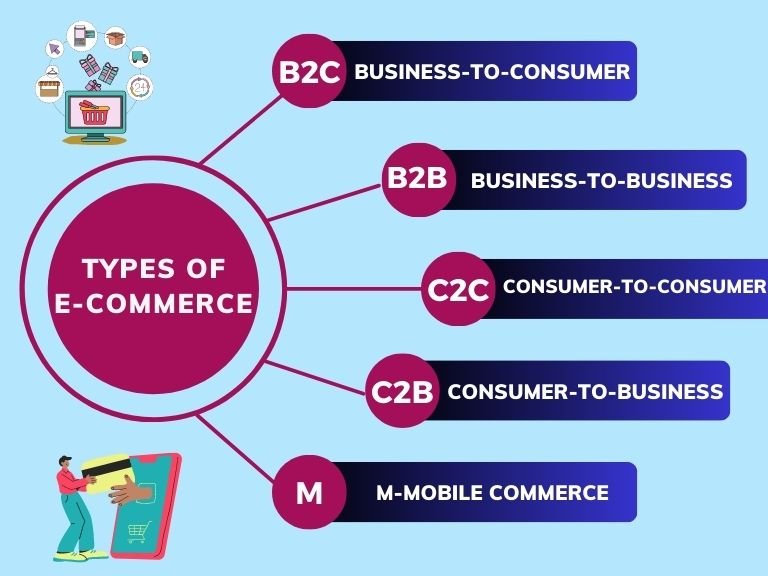Exploring the Dynamic World of E-commerce: Top 10 Types of E-commerce
Updated: 02 May 2024
38
E-commerce, or electronic commerce, via buying and selling products and services online. It involves online transactions, payments, and interactions between businesses and consumers. E-commerce has revolutionised people’s shopping, enabling convenient access to products, a global marketplace, and 24/7 availability.
Are you ready to explore the dynamic world of 10 Types of E-commerce? The possibilities seem endless, from the bustling online retail marketplace to the innovative realms of mobile commerce and subscription-based services.
In this article, we’ll take a captivating journey through the top 10 types of e-commerce, unveiling the diverse landscapes where businesses and consumers connect in the digital age.
Top 10 Types of E-commerce
There are 10 main types of e-commerce, each with its own characteristics and purposes. Here are some common types:
1. Business-to-Consumer (B2C):
B2C e-commerce involves transactions between businesses and individual consumers. It is the most familiar type of e-commerce, where companies sell products or facilities directly to customers through online platforms or websites.
2. Business-to-Business (B2B):
B2B e-commerce focuses on transactions between businesses. In this model, companies engage in online exchanges of products, services, or information with other businesses. It often involves larger order volumes and specialised products.

3. Consumer-to-Consumer (C2C):
C2C e-commerce facilitates transactions between individual consumers. Online platforms or marketplaces enable individuals to buy and sell products directly to each other. Examples include classified websites or auction platforms like eBay.
4. Consumer-to-Business (C2B):
C2B e-commerce reverses the traditional consumer-business relationship. It occurs when individuals or consumers offer products or services to businesses. Examples include freelance platforms or influencer marketing, where individuals provide services or content to businesses.
5. Mobile Commerce (m-commerce):
Mobile commerce refers to e-commerce transactions conducted via mobile appliances such as smartphones or tablets. It enables users to make purchases, complete banking transactions, or engage in other e-commerce activities.
6. Social Commerce:
Social commerce combines e-commerce with SM platforms. It involves using social media channels to reach and sell products directly to customers. Social media platforms often provide built-in features for product discovery, reviews, and purchasing.
7. Subscription-based E-commerce:
This model involves customers paying recurring fees or subscriptions to access products or services. Examples include streaming services like Netflix, subscription boxes, or membership-based websites.
8. Dropshipping:
This business model involves an online retailer selling products without physically stocking or handling inventory. When a customer confirms an order, the retailer forwards the order to the seller, who then ships the product directly to the customer.

9. Digital Products and Services:
E-commerce also encompasses selling digital items and services, such as e-books, software, online courses, digital downloads, and streaming media.
10. Peer-to-Peer (P2P) E-commerce:
P2P e-commerce facilitates direct individual transactions without intermediaries or centralised platforms. It allows individuals to buy, sell, or exchange products or services directly with each other. P2P e-commerce platforms often provide a secure transaction environment and offer features like ratings and reviews to build trust between buyers and sellers.
Examples of P2P e-commerce platforms include Airbnb for short-term rentals and media like Etsy, where individuals can sell handmade or unique items directly to customers.
Conclusion
E-commerce is a dynamic and ever-changing landscape that continues to reshape how we buy and sell products and services. This comprehensive guide has explored the top 10 types of e-commerce, from the familiar realms of B2C and B2B to the exciting frontiers of social commerce, mobile commerce, and P2P transactions.
Each class offers unique opportunities and benefits, catering to diverse business models and consumer preferences. As technology advances and consumer behaviour evolves, companies must stay adaptable and embrace the ever-changing e-commerce landscape.
Frequently Ask Question
What is e-commerce in simple terms?
E-commerce is the purchase and selling of products or services over the Internet. It involves online transactions, where businesses and consumers interact digitally to complete their purchases.
What are the three types of e-commerce?
The three types of e-commerce
a) B2C (Business-to-Consumer): Businesses sell products or services directly to individual consumers.
b) B2B (Business-to-Business): Transactions occur between businesses, where one business sells products or another.
c) C2C (Consumer-to-Consumer): Individuals engage in direct online transactions with each other, such as selling used items on a classified website.
What are the benefits of e-commerce?
The benefits of e-commerce for businesses include expanded market reach, 24/7 availability, cost savings, and the ability to personalise customer experiences.
What is the e-commerce one-word answer?
E-commerce in one word: Online transactions.
Please Write Your Comments